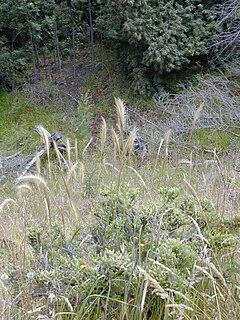
The genus Tamarix is composed of about 50–60 species of flowering plants in the family Tamaricaceae, native to drier areas of Eurasia and Africa. The generic name originated in Latin and may refer to the Tamaris River in Hispania Tarraconensis (Spain).

Aulonemia is a genus of Latin American bamboo in the grass family.

Austrostipa is a primarily Australian genus of plants in the grass family, commonly called speargrass.
Utricularia geoffrayi is a small, probably perennial, terrestrial carnivorous plant that belongs to the genus Utricularia. U. geoffrayi is native to Indochina and can be found in Cambodia, Thailand, and Vietnam. It was originally published and described by François Pellegrin in 1920. It grows as a terrestrial plant among short grasses in or around rice fields at altitudes from sea level to 1,300 m (4,265 ft). It has been collected in flower between September and December.

Euryomyrtus ramosissima, the rosy baeckea, is a shrub in the myrtle family (Myrtaceae). The species is endemic to Australia. It is spreading in habit and grows to 60 cm in height. Its leaves are dark green, long and narrow ranging from 3 to 13 mm in length and 1 to 3 mm in width. White, pink or mauve flowers with circular petals are produced between June and February in its native range.
Austrostipa variabilis is a species of grass that grows in southern parts of Australia.
Austrostipa crinita is a species of grass that grows in coastal parts of midwest Western Australia.

Triraphis is a genus of African, Arabian, Australian, and Brazilian plants in the grass family. Needlegrass is a common name for plants in this genus.

Dichelachne is a genus of Australian, Indonesian, and Pacific Island plants in the grass family. They are known commonly as plumegrasses.

Olyra is a genus of tropical bamboos in the grass family. It is native primarily to the Western Hemisphere, with one species extending into Africa.

Austrostipa pubescens, the spear grass, grows in heathland and sandy areas in eastern Australia.

Austrostipa stipoides, commonly known as prickly spear-grass or coast spear-grass, is a kind of tussock grass native to the coasts of south-eastern Australia and of New Zealand. It forms large clumps up to about 80 cm in height with smooth inrolled leaves 70 cm long and 1 mm wide with sharp tips. It is found on sea cliffs, the edges of beach dunes and salt marshes and tolerates strong winds and sea spray.

Grevillea ramosissima, commonly known as fan grevillea, is a shrub species of the family Proteaceae. It is native to south-eastern Australia.
A. flavescens may refer to:
Austrostipa flavescens, commonly known as coast spear-grass, is a species of plant in the true grass family. It is native to southern Australia. It grows as a tufted perennial tussock grass, with flat to narrow inrolled leaves, up to about 1.2 m in height. It is found on sandy, sandy loam and limestone soils as well as on dunes.
Austrostipa compressa, the compact needlegrass, originally described as Stipa compressa, is a species of grass that grows in south west Western Australia.

Nassella tenuissima is a species of grass known by the common names Mexican feathergrass, finestem needlegrass, fineleaved nassella, and Argentine needle-grass. It is native to the south-western United States, northern Mexico and Argentina. It is well-matched to climate in Australia and can be harmful to the Australian environment.

Austrostipa elegantissima, commonly known as tall feather-grass, is a species of grass in the family Poaceae. It is native to southern Australia, from Western Australia to New South Wales. It grows as a decumbent perennial in a rhizomatous tussock with widespread leaves. It lacks basal leaves. It is found in areas that are not grazed by introduced livestock, which feed on this plant.

Austrostipa setacea, the corkscrew bamboo grass, is found in many areas of inland Australia. This bunchgrass may reach 0.8 metres (2.6 ft) tall. Flowering may occur at any time of the year. This is one of the many plants first published by Robert Brown with the type known as "(J.D.) v.v." Appearing in his Prodromus Florae Novae Hollandiae et Insulae Van Diemen in 1810. The specific epithet setacea is derived from Latin, referring to the bristly leaves.

Austrostipa hemipogon is a tufted, perennial grass (a member of the Poaceae family. It is native to Australia, and found in Western Australia, South Australia, Victoria, and Tasmania.














